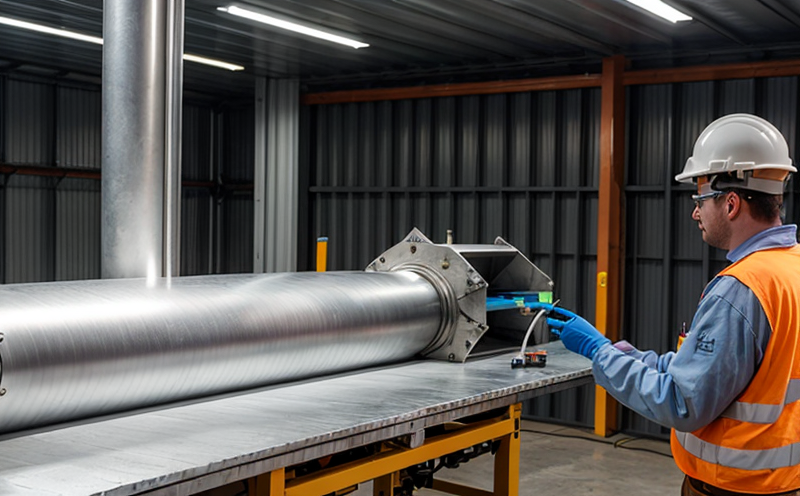EN 10045 Charpy Impact Testing of Renewable Alloys
The EN 10045 standard provides a comprehensive framework for assessing the mechanical behavior of metallic materials, particularly under dynamic loading conditions such as those encountered in impact scenarios. This test is vital for ensuring the safety and reliability of components used in renewable energy applications where robustness against sudden impacts is critical.
The Charpy Impact Test, specifically conducted according to EN 10045, evaluates the notch toughness of metallic materials by measuring their absorption capacity during impact loading. This test is particularly relevant for renewable energy sectors such as wind turbines, solar panels, and energy storage systems where materials may experience mechanical stress due to environmental factors or operational conditions.
The procedure involves subjecting a standard specimen with a specific notch configuration to controlled impact using a pendulum hammer. The absorbed energy during this impact is measured, providing critical insights into the material's resistance to brittle fracture under dynamic loading. This information is crucial for optimizing materials and ensuring they meet stringent performance requirements.
For renewable alloys used in these applications, the Charpy Impact Test plays a pivotal role in assessing their suitability by identifying any potential weaknesses that could compromise operational safety or efficiency. Understanding the notch toughness of the material can help engineers design more resilient systems capable of withstanding harsh environmental conditions without failure.
The test is typically conducted at specified temperatures to simulate real-world operating environments, such as low-temperature storage in cold climates for wind turbine components. This ensures that materials perform optimally under various conditions they might encounter during their lifecycle. By adhering strictly to the requirements outlined in EN 10045, laboratories can ensure accurate and reliable test results.
Materials like stainless steel, aluminum alloys, and high-strength alloys are frequently tested using this method due to their widespread use in renewable energy projects. The results of these tests inform decisions on material selection, process adjustments, and quality control measures aimed at enhancing product performance and safety standards.
In summary, the EN 10045 Charpy Impact Test is an essential tool for assessing metallic materials used in renewable energy applications. It provides critical data that helps manufacturers ensure their products meet rigorous international standards, thereby promoting trust and compliance within regulatory frameworks.
- Materials evaluated include stainless steel, aluminum alloys, and high-strength alloys.
- The test is conducted at specified temperatures to mimic real-world conditions.
- Results help in optimizing materials for better performance and safety.
- Strict adherence to EN 10045 ensures accurate and reliable testing outcomes.
Eurolab Advantages
At Eurolab, we pride ourselves on offering unparalleled expertise in materials science, ensuring that our clients receive the most accurate and precise test results. Our team of seasoned professionals combines extensive experience with cutting-edge technology to deliver comprehensive testing solutions tailored specifically for your needs.
We employ state-of-the-art equipment designed to meet international standards, guaranteeing consistent and reproducible results across all tests we perform. Additionally, our dedicated staff undergo continuous training to stay updated on the latest developments in both methodology and instrumentation. This commitment ensures that every aspect of your testing process is handled with utmost care and precision.
Our facilities are equipped with sophisticated apparatus capable of performing a wide range of mechanical property tests beyond just Charpy Impact Testing, providing additional value-added services to complement our primary offerings. Whether you require comprehensive material analysis or specialized testing under unique conditions, Eurolab has the capabilities needed to support your project.
Choosing Eurolab means leveraging years of industry expertise combined with advanced technology and unwavering quality assurance practices. We are committed to delivering top-notch service that exceeds expectations while maintaining strict adherence to relevant standards like EN 10045.
Why Choose This Test
The Charpy Impact Test according to EN 10045 is indispensable for assessing the mechanical properties of metallic materials, especially those utilized in critical sectors like renewable energy. It helps identify potential vulnerabilities within the material structure that could lead to failures under dynamic loading conditions.
By subjecting specimens with notches—a common flaw in many industrial applications—the test reveals how well a given alloy resists brittle fracture when subjected to high-energy impacts. This insight is invaluable for manufacturers looking to enhance product durability and safety while complying with stringent regulatory requirements.
The results from this test play a crucial role in selecting appropriate materials for specific applications, ensuring they can withstand the rigors of their intended environment without compromising operational integrity or reliability. For instance, wind turbine blades made from durable alloys tested via this method would be more resistant to damage caused by frequent gusts and harsh weather conditions.
Moreover, compliance with internationally recognized standards like EN 10045 adds credibility to the testing process, making it easier for companies to meet regulatory obligations. The data obtained through these tests serves as a foundation for continuous improvement initiatives aimed at enhancing overall product quality and performance.
In conclusion, choosing Charpy Impact Testing according to EN 10045 offers numerous benefits including enhanced material selection, improved product durability, increased compliance with industry standards, and greater confidence in meeting regulatory requirements. These advantages make it an indispensable tool for any organization involved in the development or manufacturing of components used in renewable energy systems.





